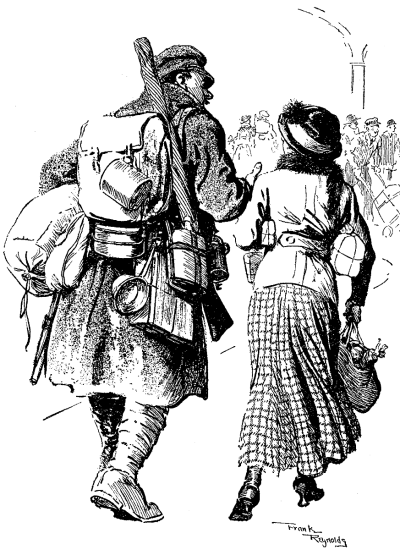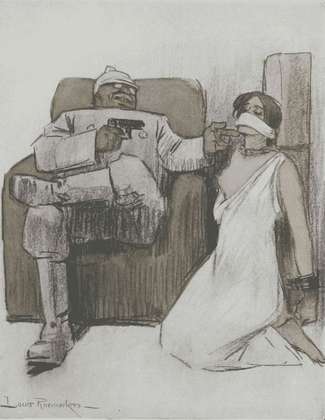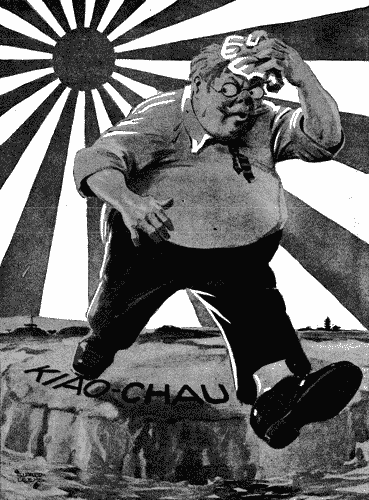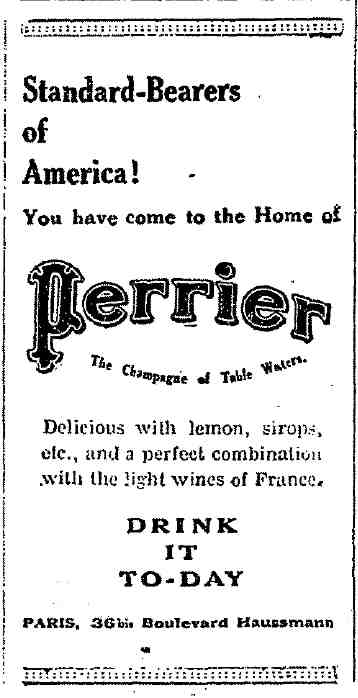Newspaper editorial cartoons came into their own during the Spanish-American War and by the time of WWI any newspaper worthy of the name had at least one editorial cartoonist on its staff. Free-lance syndicated cartoonists were also popular and commanded high prices for their work because they helped drive newspaper sales.
Governments quickly realized the potential uses of editorial cartoons for their propaganda uses in supporting the war effort at home and condemning their enemies abroad. Within a fairly short time most newspaper editorial cartoons had fallen into the trap of creating and perpetuating stereo-types that remained long after the War’s end: the German Hun, The English Lion, etc. Still, rarely, an occasional work of art appeared in cartoon form on a newspaper’s editorial pages. Those are the ones we remember.
Fortunately the internet has provided us with an aide memoir that today gives us access to a wide variety of newspaper editorial cartoons from WWI. These sites often divide the cartoons by country of origin, newspaper source, theme, etc. Some of them are quite specialized. For instance, who would have thought that there would be a whole genre of WW1 related cartoons developed for “black” newspapers? Or that the artistic worth of some cartoonists, such as Louis Raemaekers would have spawned a thriving mini-industry on eBay?
One special source of American-themed WW1 cartoons was “The Stars and Stripes,” the newspaper published in Europe by and for American dough-boys by command of Gen. John J. Pershing, who realized the morale value of an American home-style newspaper for the soldiers at the front. “The Stars and Stripes” was published over a 71-week run and today is available on a CD-rom for $10 from BACM Research. I highly commend it to any WW1 or Diplomacy history fan. The following cartoons and commentary are all taken from the internet and are in the public domain. You can find out more about them and more cartoons like them with a Google or Yahoo search on the topic “WW1 newspaper editorial cartoons.”

GERMAN BULL: “I know I’m making a rotten exhibition of myself,
but I shall tell everybody I was goaded into it.”
In this cartoon the Germans are portrayed as a bull running amok in a “neutral china shop” bearing the flags of the neutral nations. The caption reads: “I shall tell everybody that I was goaded into it.” The point of the cartoon is that the Germans would attack neutral countries, such as Belgium, with the excuse that they had been provoked by the actions of the victims. The original cartoon appeared in the British satirical magazine Punch, during the early part of the War.

“I say, old girl, do let me carry something.”
In this cartoon, a British soldier laden with his heavy kit and weapons offers to help a lady with her shopping bags. The cartoon, like many others like it, glorifies the self-sacrifice and gentility of the Allied troops, in contrast to the rapacious German soldiers. This cartoon appeared in Punch.

In this cartoon the German Kaiser is seen mocking the Belgian King, telling him that he has lost everything. The Belgian replies that he has not lost his soul. The cartoon refers to the fact that neutral Belgium has been invaded and largely overrun by the Germans as they sought to outflank the French and British armies by pushing along the English Channel towards Paris. The Belgians were vastly outnumbered but fought bravely against the Germans.

This is a cartoon by Louis Raemaekers.
The artist writes: “The harvest is plentiful, but the labourers are few”: here is only one, but he is quite sufficient — “the reaper whose name is Death,” a skeleton over whose bones the peasant’s dress — a shirt and pair of ragged trousers — hangs loose. The shirt-sleeves of the skeleton are turned well up, as if for more active exertion, as he grasps the two holds of the huge scythe with which he is sweeping down the harvest. This is not war of the old type, with its opportunities for chivalry, its glories, and its pride of manly strength. The German development of war has made it into a mere exercise in killing, a business of slaughter. Which side can kill most and itself outlast the other? When one reads the calculations by which careful statisticians demonstrate that in the first seventeen months of the war Germany alone lost over a million of men killed in battle, one feels that this cartoon is not exaggerated. It is the bare truth.

In this cartoon a brutish German soldier is seen “seducing” a young maiden who is bound and gagged. The writer G.K. Chesterton had this comment about the cartoon.
“The cartoon in which the Prussian is depicted as saying to his bound and gagged victim, “Ain’t I a lovable fellow?” is one of the most pointed and vital of all pictorial, or indeed any other, criticisms of the war. It is very important to note that German savagery has not interfered at all with German sentimentalism. The blood of the victim and the tears of the victor flow together in an unpleasing stream. The effect on a normal mind of reading some of the things the Germans say, side by side with some of the things they do, is an impression that can quite truly be conveyed only in the violent paradox of the actual picture. It is exactly like being tortured by a man with an ugly face, which we slowly realize to be contorted in an attempt at an affectionate expression. In those soliloquies of self-praise which have constituted almost the whole of Prussia’s defence in the international controversy, the brigand of the Belgian annexation has incessantly said that his apparent hardness is the necessary accompaniment of his inherent strength. Nietzsche said,: “I give you a new commandment. Be hard.” And the Prussian says: “I am hard,” in a prompt and respectful manner. But, as a matter of fact, he is not hard, he is only heavy. He is not indifferent to all feelings, he is only indifferent to everybody else’s feelings. At the thought of his own virtues he is always ready to burst into tears. His smiles, however, are even more frequent and more fatuous than his tears, and they are all leers like that which Mr. Raemaekers has drawn on the face of the expansive Prussian officer in the arm-chair. Compared with such an exhibition, there is something relatively virile about the tiger cruelty which has occasionally defaced the record of the Spaniard or the Arab. But to be conquered by such Germans as these would be like being eaten by slugs.”

This cartoon from the periodical “Simplicissimus,” Munich portrays the British Lion (traditional symbol of Britain) as infested with Japanese fleas. The message it conveys is that the British are being influenced towards war by the Japanese diplomatic maneuvers.

Another cartoon from the German periodical Simplicissimus showing a lone German knight standing firm against monster-headed waves. The image portrays the resolve of the Germans to defend their stronghold in China. It was published before the fall of Tsingtao.

The Under Study: The Triple Alliance Revised and Corrected
This Italian cartoon from the Numero in Turin shows Germany and Austria seated next to a smaller figure. The name on the middle chair used to be Italy but it has been crossed out and replaced with Turkey. It refers to the fact that originally Italy was a member of the Triple Alliance between Austria, Germany and Italy and should, pursuant to its treaty obligations, have fought on the side of the Germans. Instead, Italy (the weaker of the three parties) remained neutral and eventually entered the war on the side of the Allies. The cartoon comments on the fact that the Germans and Austrians have found a replacement in Turkey, also a weaker power that they can manipulate.

In this Italian cartoon, German soldiers are shown fixing up a devastated Belgian city and re-paving the shell-pocked roads with skulls of their Belgian victims. Alleged German atrocities against the civilian population of Belgium were fertile ground for Allied war propaganda. On the other hand, German war propaganda blamed Belgium and Britain for the war.

This cartoon from La Vie Parisienne, Paris shows what the French are wishing for: A Million English Soldiers to Help Us Drive the Germans from France and Belgium.

At the start of the war the Kaiser had supposedly ordered a New Year's dinner at a posh French hotel with the expectation that Paris would be in the hands of the Germans by year end. This cartoon mocks the German's over-confidence by pointing out that the Kaiser has not been able to come and enjoy his dinner.

A fat German "Barbarian" is shown as retreating from his colonies in China in the face of the heat from the Rising Sun of Japan. Contrast this portrayal of the German as fat and cowardly with the German cartoon depicting a lone and brave German knight defending the German outpost in China against overwhelming odds.

The Germans are depicted as driving a war weary Ottoman Empire which they control as they would a horse. - From Punch, London.
World War I is when you can see a vast change in the meanings of cartoons. During the first World War, cartoons were used to not only show the same characteristics as previous cartoons but also to create a sense of pride and passion with the country. Cartoonists used this time of grief and fear to gain support behind the efforts of The United States.

This cartoon depicts World War I President Woodrow Wilson. In his left hand is a newspaper with headlines "American Ships Sunk Without Warning: American Lives Lost." In his right hand, he begins to draft a Declaration of War. This cartoon was used to bring up the idea of war to the American people.
More cartoons like this began to surface during war time. The purpose of these cartoons was to gain awareness. Certainly no one was excited for war but the cartoons helped to show that it may be necessary to fight for what we believe in as free citizens. Soon cartoons started popping up showing the enemy and asking for citizens to donate or enlist, to do whatever was necessary for your country. Cartoon became propaganda. This was the first major shift in how we view political cartoons today. The wartime cartoons are meant to gain support and change people’s view points about subjects that were previously unmentioned.

This cartoon shows Wilson steering a boat between "war" and "intervention" heading towards "justice."

The Gap In The Bridge
The League of Nations was the international government created at the end of World War 1. The five major countries in controlling power are creating the bridge.
The next cartoons by the popular British cartoonist Tom were created as part of the 100th Centennial of WW1.


This last cartoon is from “Stars and Stripes” and features a French ad that appeared in the paper.

We have found the source of Larry Peery's vitality. It's Peerier bubbles! (Ed.)
 |
Larry Peery (peery@ix.netcom.com) |
If you wish to e-mail feedback on this article to the author, and clicking on the envelope above does not work for you, feel free to use the "Dear DP..." mail interface.

